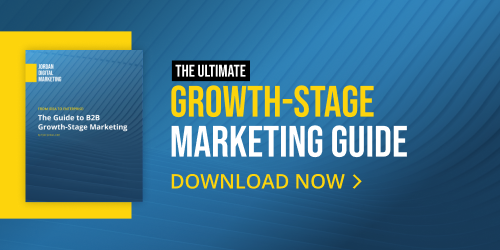Google's Original Conversion Value Metric: What to Know
When a campaign is going well, one question we always get from clients is: “How can we scale this success?” As a business partner to our clients, our job is not only to maintain this momentum but also to take wins to new heights.
In this blog series, we’ll dive into our tried-and-true methods of scaling B2B accounts, according to each platform. Let’s get started by taking a look at how to scale B2B Google Ads accounts – specifically, let’s dig into six proven strategies to propel your accounts toward unparalleled growth. (Stay tuned for posts on how to scale B2B campaigns in Facebook, LinkedIn, and Capterra!)
1. Evaluate Budgets
A good place to start when considering scaling spend is by evaluating your current campaigns. Ask yourself these critical questions to begin:
- Is the overall account search impression share less than 60-70%?
- Are any campaigns individually less than 60-70% impression share?
- Are any campaigns losing search to budget?
- Are any campaigns flagged for being limited by budget?
If you answered yes to any of these questions, then chances are your campaigns have untapped potential in regards to spend. Depending on your KPI goals and campaign performance, we recommend starting with a 10-20% daily budget increase on campaigns and monitoring their performance.
2. Expand Keywords
Another way to fuel scaling efforts is by broadening your keyword horizons. Using a multi-faceted approach to keyword expansion will give you the best results. We recommend the following tactics:
- Search Term Report: Search term reports allow you to see which terms trigger your ads. You can then evaluate the keywords based on your KPIs and add any additional relevant keywords that are hitting at or below your goals.
- Competitor Research: Analyze your competitors’ keyword strategies to identify keywords that could complement your campaigns using SEMrush’s Keyword Gap tool.
- SERP Suggestions: Leverage search engine results page results, features, and related search suggestions to find related keywords for campaigns.
- Broad-Match & Industry-Specific Keywords: Incorporate both broad-match and industry-specific keywords to capture a wider audience while still catering to your niche.
- ChatGPT for Keyword Research: Use a prompt like “Make a list with <keyword> related to <details> that a < audience> might use to search on Google” to refine your keyword list using AI.
- Google Recommendations: Navigate to the recommendations tab on your Google account itself and see if there is an “Add New Keywords” recommendation.
3. Target New Audiences
You can also use the success of your top-performing keywords to launch additional campaigns that target specific in-market audiences. This move can significantly expand your reach and engagement with targeted audiences.
4. Add New Campaign Types
Exploring new campaign types on Google can also help optimize your scaling efforts. Consider these campaign types (and put a test-and-measure framework in place if you choose to use them):
- Performance Max: This campaign type is particularly effective for campaigns targeting strong audiences and utilizing video content.
- Discovery: The Discovery campaign type is perfect for leveraging Google’s machine-learning algorithms to enhance campaign performance and reach.
5. Test Different Bid Strategies
Bid strategies can play a pivotal role in scaling Google accounts. Here are a few strategies we suggest testing:
- Portfolio bids for smaller spending accounts: Implement portfolio bidding strategies to manage smaller spending accounts more effectively.
- Max Conversion > tCPA: Test out the max conversion bidding strategy, prioritizing maximum conversions while staying within a desired cost-per-acquisition range.
- Campaign-level conversion actions: Fine-tune your bidding approach by implementing campaign-level conversion actions, ensuring your bids align closely with your conversion goals.
- Max Conversion Value > tROAS: Opt for max conversion value when your primary goal is maximizing conversion value, even if it means adjusting your target return on ad spend.
6. Add Additional Locations
If your business operates internationally, an easy way to scale is by testing campaigns in new geographic locations. Expanding your reach into different countries can help you tap into fresh audiences and markets that might be just as receptive to your B2B offerings.
Start Scaling Your Google Ads Account With JDM
Ready to take your B2B ads to the next level? Jordan Digital Marketing’s strategic approach, derived from years of experience and industry knowledge, will guide you in optimizing your campaigns for growth.
Whether you’re evaluating budgets, expanding keywords, or experimenting with bidding strategies, our team is here to ensure your success in scaling your B2B accounts. Reach out to us today for a free paid ads audit!
Tags:

Aug 29, 2023 10:00:00 AM


-Dec-17-2025-09-01-13-5742-PM.png?width=500&height=500&name=Regular%20Blog%20Hero%20(2)-Dec-17-2025-09-01-13-5742-PM.png)


-Dec-04-2025-09-58-32-5416-PM.png?width=500&height=500&name=Regular%20Blog%20Hero%20(1)-Dec-04-2025-09-58-32-5416-PM.png)